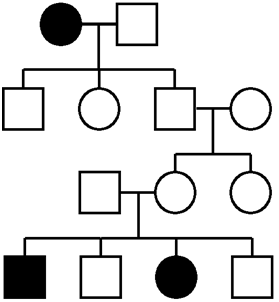Reference no: EM131134776
Problem: Genetics
1. For the gene that can give rise to sickle cell anemia there are two forms of it (we will designate them S and s). The people corresponding to the filled in shapes (circles [females] or squares [males]) represent those that have been tested for sickle cell anemia (and in fact tested positive) and tested positive. The two individuals indicated by the arrows were also tested but tested negative for sickle cell anemia and sickle cell trait. No other individuals in this pedigree have been tested for either sickle cell anemia or sickle cell trait. Use your understanding of genetics to list what possible genotypes (remember, the possible ones are SS, Ss, or ss) exist for all people in the pedigree, regardless of whether they have been tested or not. You should fully appreciate that for some people you may have to list more than one genotype, not because a person would have more than one but because more than one might be possible given the information that you have.

2. (a) For any one child born to the original parents in the pedigree, what is the chance that the child would have sickle cell anemia. Show your work.
(b) For any one child born to the original parents in the pedigree, what is the chance that the child would have sickle cell trait? Show your work.
3. Imagine the following scenario. Scientists have identified a gene that like the gene for sickle cell anemia, exists in two forms. Scientists are wondering whether the gene might be related to having heart attacks. The following table examines the distribution of the two forms of the gene in people who are over the age of 60 and have had a heart attack compared.
|
Allele
|
Above 60 who have had heart attacks
|
Above 60 with no heart attacks
|
|
H
|
645
|
4800
|
|
h
|
123
|
915
|
(a) Calculate the frequency with which the H allele appears in heart attack victims.
(b) Calculate the frequency with which the h allele appears in heart attack victims.
(c) Use the observations in the table to assess the theory that the h allele determines heart attacks (comparable to the s allele determining sickle cell anemia).
(d) Use the observations in the table to assess the theory that the y allele influences the likelihood of having a heart attack.
4. Below is more simulated (model but not real) data. In this case scientists are trying to find genes that might influence the probability of getting diabetes; there were four candidate (i.e., possible) genes that were being examined. Assume the 10,000 people surveyed were in Minneapolis, Minnesota.
|
Gene
|
Allele
|
# of people with diabetes/total*
|
Risk of Diabetes with allele 1
|
Risk of Diabetes with allele 2
|
Relative Risk
|
|
Gene 1
|
C/T
|
112/6600; 54/3400
|
.017 (1.7%)
|
|
|
|
Gene 2
|
T/C
|
29/300; 174/9700
|
|
|
|
|
Gene 3
|
C/G
|
30/1700; 152/8300
|
|
|
|
|
Gene 4
|
G/A
|
712/8300; 31/1700
|
|
|
|
* it is a bit tricky to read this column. The first numerator/denominator combination refers to the number of people with the first allele and the total number of people examined with that allele; the second numerator/denominator combination refers to the number of people examines with the 2nd allele and the total number of people examined with that allele.
(a) Fill in the last three columns of the table. To fill in the first of the blank columns, pay attention to the first pair of numbers in the third column. I have filled in the first case as an example. This column assesses the frequency (or you could put it in percentage as I have done in parentheses) of diabetes in people who have a "C" in a particular position in Gene 1. The 2nd blank column will require you to determine the frequency of diabetes among people who have a "T" at that particular position in Gene 1. Finally, the last column is to determine the relative risk. This term means the likelihood of getting diabetes if you have a "C" at that position in Gene 1 relative to having a "T" at that position. In order to determine that number, divide the first blank column by the second blank column. If the number is greater than 1, then it means that you are that times more likely to get diabetes if you have allele 1 compared to allele 2. For example, if the number were 4.5 in the relative risk column then that would mean you are 4.5 times more likely to get diabetes if you have a "C" compared to if you have a "T."
(b) Which of these genes seems to have some effect on having diabetes? Explain your answer.
(c) In this scenario, allele 1 of gene 2 is found at a frequency of 300 per 10,000 Minnesotans (as shown in the table). Imagine you go to Mexico and survey Pima Indians and find that the frequency of allele 1 of gene 2 is found at a frequency of 800 per 10,000 people. Why might this observation be of interest?